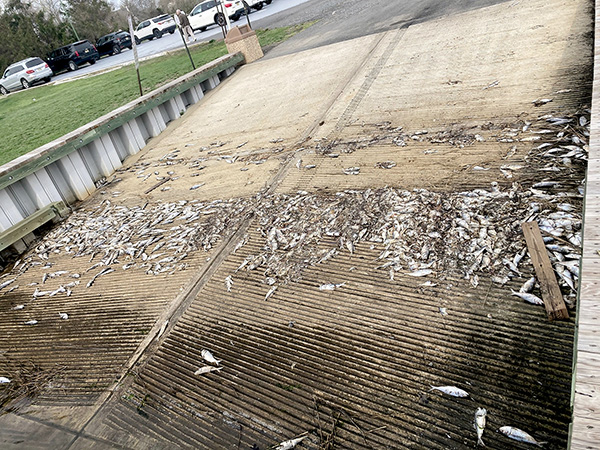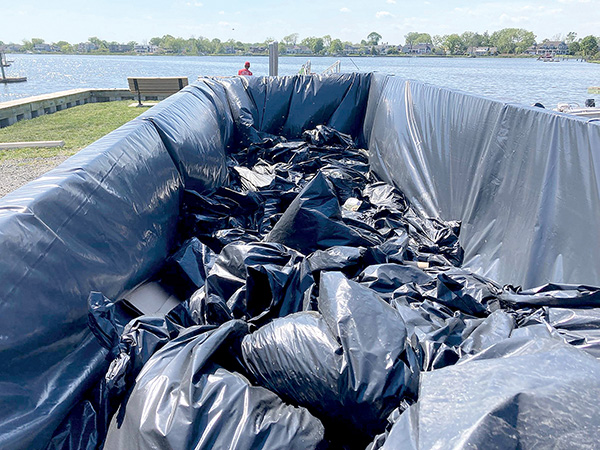
By Elizabeth Wulfhorst | ewulfhorst@tworivertimes.com
OCEANPORT – Like many in the Two River area, Oceanport residents have watched since last month as thousands of dead fish accumulated in their water and along their shoreline. For weeks they have endured the sight and stench of the rotting carcasses. But the borough put an end to this particular misery May 12 when they began a cleanup effort that cleared around 6,000 pounds – nearly 3 tons – of dead and decaying menhaden from its shores.
Oceanport Mayor Jay Coffey said the cleanup covered about 80 percent of the borough’s waterways.
In early April, the New Jersey Department of Environmental Protection confirmed the fish bacterium Vibrio anguillarum was causing a massive die-off of menhaden in the Navesink and Shrewsbury rivers. Atlantic menhaden, also known as bunker fish, are a plentiful, oily, prey fish in the herring family, harvested as baitfish and for use in supplements, livestock feed and cosmetics, among other things.
The NJDEP reported that similar largescale die-offs have been seen since the fall in coastal areas from Rhode Island to New Jersey.
Oceanport was in conversations with neighboring communities like Long Branch about possibly pooling resources to complete a regional cleanup. But after analyzing the topography, Coffey say they realized Oceanpor t would need a different approach to getting rid of the dead fish.
“Long Branch was using the services of a jet vac truck,” he said, “but their fishkill had a different layout to it. They had several incredibly hot spots where it was knee-deep in dead fish and these little ravines that run along Patton Avenue.”
He noted that Oceanport’s topography meant there wasn’t any one spot along its approximately 11 miles of shoreline where the fish were trapped in great numbers. It was “still substantial,” he said, but not concentrated to the point where using a vacuum was warranted. While dead fish collected at bulkheads, they might be gone in a few days when the wind changed. But those washed into seagrass along the shore would stay there when the tide went out.
“We needed to be more surgical in our approach,” Coffey said.
The fish deposits are so severe, leaving them to decay naturally was not a great option because the piles are causing other issues, aside from the smell.
Coffey called the decaying fish a “buffet” for maggots and flies. “The fly population in Oceanport is off the charts,” he said.
Through a recommendation from the mayor of Aberdeen, the borough contracted with Ken’s Marine Services of Bayonne. The company sent two boats and workers who, wearing waders up to their chests, removed the fish with rakes and their hands into garbage bags. The boats utilized nets to remove the dead fish still floating in the water. The borough hired two dumpsters which were taken to the Monmouth County Reclamation Center when filled.

Coffey said the removal project, which the borough expected would take two and half days, ended up taking more than four. They budgeted $25,000 and he expects to come in under that number.
Towns along the shore have gotten support from local legislators like Sen. Vin Gopal, who Coffey said is working to get municipalities some reimbursement from the state for dead fish cleanup.
The mayor noted the hard work of councilman Tom Tvrdik and business administrator Donna Phelps who coordinated the project.
Other towns are also addressing the growing piles of dead fish as best they can. The Borough of Monmouth Beach sent an email to residents notifying them of a fish pickup May 14. Residents were instructed to double bag the carcasses in heavy duty plastic garbage bags and place them at the curb.
A note from Mayor David Stickle on the Monmouth Beach website explained that the commissioners were looking at hiring a contractor to remove the fish and also requesting reimbursement from the state. For now, the borough “will be appropriating funding on an emergency basis” to cover removal costs.
According to the message, the Monmouth Beach Department of Public Works periodically clears the boat ramp and “will continue to do so as needed.”
Coffey said, because the Monmouth Beach topography is similar to Oceanport’s, he believed the council was also looking to hire Ken’s Marine for a larger removal project.
A follow-up email to residents, showed that to be the case. According to the message, work began May 20 and was expected to continue “several days.” Ken’s Marine Services will be removing the dead fish from both public and private area shorelines.
“We will not get every carcass but we expect a vast improvement. Remember the fish kill is ongoing and is likely to continue. We will take additional action as needed,” the message said.
Local environmental organization Clean Ocean Action has been monitoring the situation closely. In a blog post dated April 21, COA noted the “NJDEP is conducting research to determine why this bacterial outbreak is so severe, as there is currently no documented cause. They are also in communication with other state and federal agencies about similar incidents.”
While currently only causing bunker fish die-offs, COA said “literature suggests” the Vibrio bacterium could affect other types of fish.
The NJDEP said the “bacterium is generally not known to be harmful to humans. However, contact with water in areas where fish die-offs are occurring should be avoided as a precaution.”
During the cleanup, Coffey noted the water in the Pleasure Bay side of the river is “brown” and nothing is visible below the waterline. He likened it to “Willy Wonka’s choc- olate river.” In the Blackberry Bay area, the water is very clear, but Coffey said there is an overwhelming amount of seaweed.
He said it is something they will be bringing to the attention of state and federal officials.
The NJDEP has a list of FAQs on its website with more information about the menhaden die-off and the bacterium causing it at nj.gov/dep/fgw/news/2021/menhaden_up- date2_faqs.htm.
The department recommends citizens report new fishkills at 877-WARN-DEP (877-927-6332).
They have deployed continuous monitoring buoys which will collect water quality data starting this month through October. This data “may provide insight to the stressors and environmental factors impacting menhaden.” One buoy is located in the Navesink River east of the Route 35 bridge, the other two are in Keansburg and Keyport. The buoys will transmit data to the continuous monitoring web page at njdep.rutgers.edu/continuous/.
This article originally appeared in the May 20 – 26, 2021, print edition of The Two River Times. It was updated May 20 online to reflect the information about Monmouth Beach’s cleanup.














